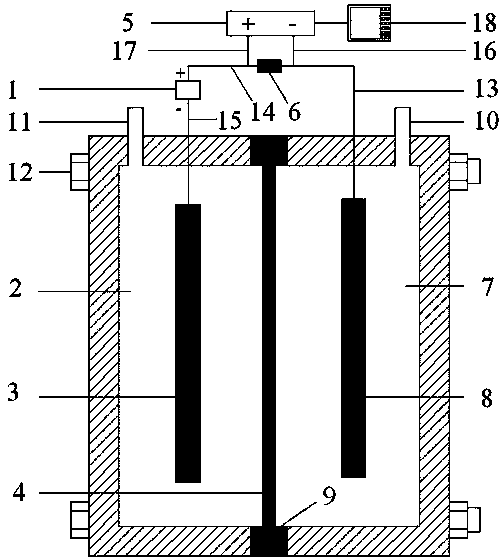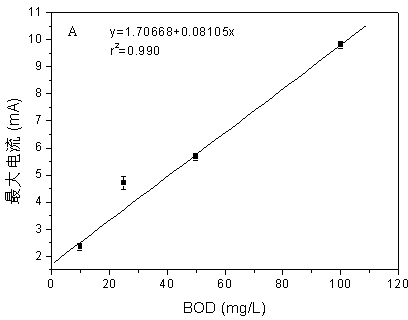Device and method for quickly measuring BOD (biochemical oxygen demand) based on microbial electrolysis cell technology
A microbial electrolysis cell, biochemical oxygen demand technology, applied in measuring devices, material analysis by electromagnetic means, instruments, etc., can solve the problems of narrow linear range, high detection limit, low reduction efficiency, etc., and achieve a wide range of resistance to heavy metals. , The effect of short detection time and wide linear range
- Summary
- Abstract
- Description
- Claims
- Application Information
AI Technical Summary
Problems solved by technology
Method used
Image
Examples
Embodiment 1
[0041] 1. Preparation of assay device:
[0042]The structure of the measuring device is as figure 2 As shown, it includes: potentiostat 1, cathode chamber 2, platinum-coated titanium mesh cathode electrode 3 (38×50×2 mm, surface area is about 50 cm 2 ), Proton Exchange Membrane (PEM) 4, data acquisition system 5, resistor 6, cathode chamber 7, graphite felt anode electrode 8 (40×50×5 mm, GF series, Electro-synthesis Co., USA) , Silicone gasket 9, sample inlet 10, sample inlet 11, stainless steel screw 12, titanium wire 13, titanium wire 14, titanium wire 15, wire 16, wire 17 and recording and display device 18.
[0043] The cathode chamber 2 and the anode chamber 7 are respectively composed of a polymethyl methacrylate (PMMA) plate (80×100×20 mm), and a cavity of 40×60×12 mm is carved in the middle of each plate. The cathode chamber 2 and the anode chamber 7 of the microbial electrolytic cell are respectively provided with sampling ports 11 and 10 .
[0044] Proton exchang...
PUM
 Login to View More
Login to View More Abstract
Description
Claims
Application Information
 Login to View More
Login to View More - R&D
- Intellectual Property
- Life Sciences
- Materials
- Tech Scout
- Unparalleled Data Quality
- Higher Quality Content
- 60% Fewer Hallucinations
Browse by: Latest US Patents, China's latest patents, Technical Efficacy Thesaurus, Application Domain, Technology Topic, Popular Technical Reports.
© 2025 PatSnap. All rights reserved.Legal|Privacy policy|Modern Slavery Act Transparency Statement|Sitemap|About US| Contact US: help@patsnap.com



